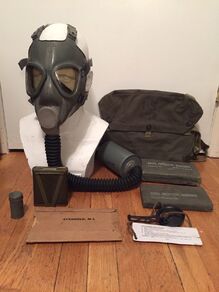History[]
The unsatisfactory weight and bulk of the M2 Series Army Service Masks led to the development of the M3-10A1-6 Lightweight Service Gas Mask in late 1942. Early productions of the M3 Lightweight were plagued with manufacturing issues so to fill the demand for initial procurement of 150,000 lightweight service masks, the production of the M4 lightweight was approved in late 1942 as a stop-gap. M4's were manufactured by taking stocks of M2A2 facepieces and turning it into a lightweight service mask by giving it an oronasal cup, 457 mm (18-inch) M3 hose, or cut down MII hoses, M10 or M10A1 canister, the addition of the upgraded M7 harness, and an M6 lightweight carrier. Although these masks began production in late 1942, they did not see any significant production until late 1944 and 1945, which is when the flaws of neoprene were fully appreciated.
With the introduction of Neoprene M3's in late 1943 because of dwindling natural rubber supplies, a new problem with these new masks was discovered. Neoprene was found to become unusable in cold weather due to the hardening of the mask under freezing temperatures, while the natural rubber remained flexible even in cold weather. This problem wasn't fully realized until the winter of 1944 and was a serious problem, so the production of M4's saw larger scale production around this time, and by the summer of 1945, all neoprene M3 masks in Europe were being replaced by the M4, of course, any natural rubber M3's remained.
After the war, M3's and M4's received an upgraded exhale valve designated the C15, which had better winterization properties and also protected the valve from debris better than the earlier M8 exhale valve. These M4's were designated M4A1-10A1-6, with the "A1" signifying the upgraded C15 outlet valve. Also, a large amount of super small sized M2A2's was reconditioned into the M4 lightweight configuration after WW2 by simply cutting the hose down to 457 mm (18 inches) and then attaching an M10A1 canister directly to where the hose was cut and then secured using wire and tape and was also given an M6 carrier. For some reason, the post-war size super small M4 did not receive an oronasal cup, upgraded M7 harness, or new hardware, but existing examples of wartime super small M4 lightweights will have the nose cup, different hardware, and the M7 harness. The post-war size super small is the most common of the lightweight series of masks with the wartime size super small M4 lightweights being extremely rare. Size large M4 lightweights also exist, but like the wartime size super small M4, they are extremely rare. These masks were issued as a standard service mask alongside the M3, M9, and M9A1 well into the late 1950s, and then finally being obsoleted on August 18, 1961.
Identifying the M3 and M4 Series Lightweight Service Gas Masks[]
Both the M3 and M4 series Lightweight Service Gas Masks use similar hardware, but have only one or two distinguishing differences. It can be difficult to distinguish the M4 from the M3 series masks due to the near-identical facepiece and sometimes same Class 'B' Rubber. This table lists the components and construction details across the M3 and M4 series variants:
| Feature | M3 | M3A1 | M4 | M4A1 |
|---|---|---|---|---|
| Facepiece | M3 | M3 | M2A2 | M2A2 |
| Color | Grey or Black (Neoprene) | Black (Neoprene) | Grey | Grey |
| Harness Assy | MIIA1 or M7 | M7 | M7 | M7 |
| Harness Attach | (1) | (1) | (2) | (2) |
| Canister | M10/M10A1 | M10A1 | M10/M10A1 | M10A1 |
| Rifle Skid (3) | No | No | Yes | Yes |
| Outlet valve (4) | M8 assy | C15 assy | M8 assy | C15 assy |

post war M4A1-10A1-6 Lightweight Service gas Mask
(1) Harness attaches to the M3 and M3A1 masks with a riveted clip, flat against the mask and near the edge. Lowest strap, at the cheek, is attached to a tab at a 45° angle, at the edge of the mask.
(2) Harness attaches to the M4 and M4A1 masks with a riveted clip on pads. The lowest strap is attached horizontally at the cheek, with the clip pad attachment point forward from the edge of the mask. The two straps on each side are held against the mask by a bridge loop.
(3) The rifle skid is a ridge molded into the mask material, intended to prevent entanglement between the mask wearer's rifle and the harness straps.
(4) The M8 outlet valve assembly has an external guard with a concentric circle grill, as used with the M2A2 Training and Service Masks. The C15 outlet valve assembly has a fully-encapsulating rubber 'shroud' cover with bumps on the interior for de-icing the valve.
Carrier, Mask, Lightweight Service, M6[]

The M6 Carrier was used for both the M3 and M4 masks (and other lightweight masks) to hold the mask itself, the canister, plus accessory items such as the Anti-Dimming Kit, M1 Eyeshields, Two Individual Protective Covers, C3 Waterproofing Kits, and M4, M5, or M5A1 Protective Ointments. The bag has interior pockets for accessories and is stenciled with "US" along with the Chemical Corps Insignia on the top opening flap, and "Army Lightweight Service Mask" on the exterior front, near the bottom. The M6 Carrier has a top closure that is secured with three LTD fasteners. Like other WWII webbing and bags, the bag color was OD #3 early in the war but changed to the darker OD #7 shade in 1943.
